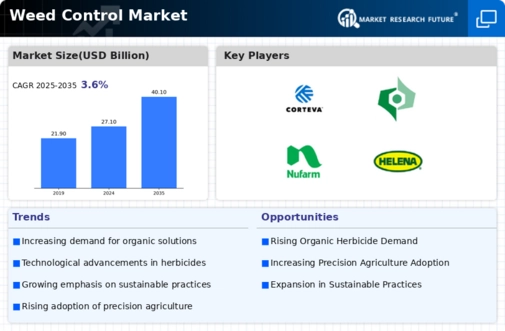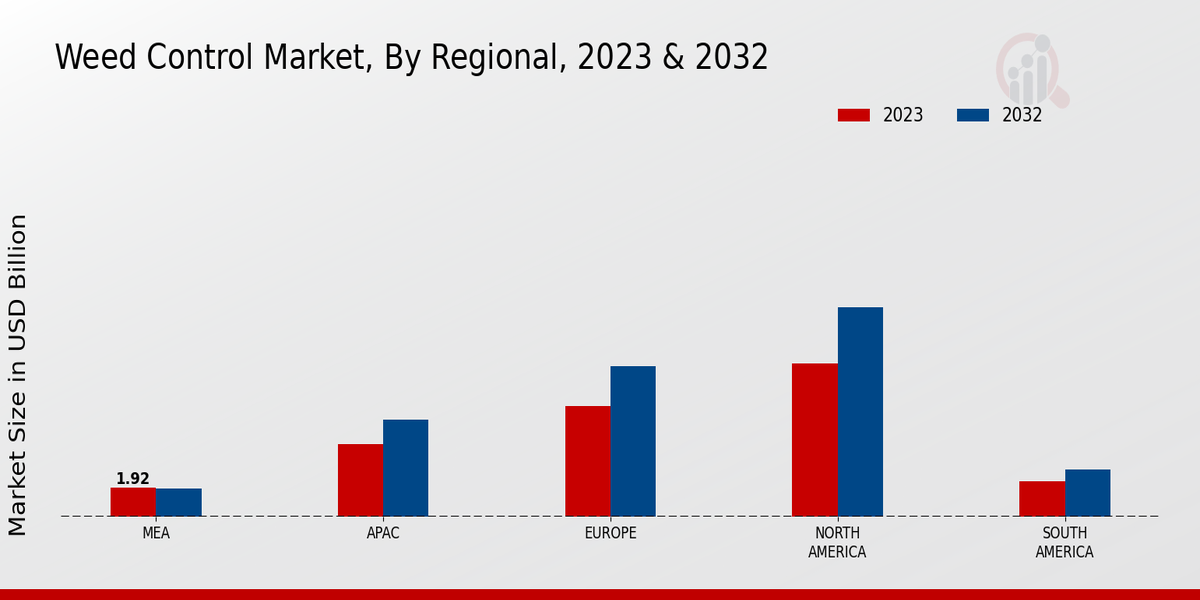Market Growth Projections
The Global Weed Control Market Industry is projected to experience substantial growth over the coming years. With a market value expected to reach 27.1 USD Billion in 2024 and 40.1 USD Billion by 2035, the industry is poised for a robust expansion. The anticipated CAGR of 3.62% from 2025 to 2035 indicates a steady increase in demand for effective weed management solutions. This growth is influenced by various factors, including technological advancements, regulatory support, and the rising need for sustainable agricultural practices. The market's trajectory suggests a dynamic landscape where innovation and environmental considerations will play pivotal roles.
Regulatory Support for Herbicide Use
Government regulations play a crucial role in shaping the Global Weed Control Market Industry. Many countries are implementing policies that support the use of herbicides while ensuring safety and environmental protection. These regulations often promote the development and registration of new herbicides, which can lead to increased market opportunities. Furthermore, initiatives aimed at educating farmers about proper herbicide application and integrated pest management are enhancing the effectiveness of weed control measures. As regulatory frameworks evolve, they are likely to foster innovation and growth within the Global Weed Control Market Industry.
Rising Demand for Sustainable Practices
The Global Weed Control Market Industry is experiencing a notable shift towards sustainable agricultural practices. Farmers and landowners are increasingly adopting integrated weed management strategies that minimize chemical usage. This trend is driven by consumer preferences for organic products and regulatory pressures to reduce chemical inputs. As a result, the market is projected to reach 27.1 USD Billion in 2024, reflecting a growing commitment to environmental stewardship. Sustainable practices not only enhance soil health but also improve crop yields, thereby supporting the overall growth of the Global Weed Control Market Industry.
Growing Awareness of Invasive Weed Species
The increasing awareness of the impact of invasive weed species is driving demand within the Global Weed Control Market Industry. Invasive weeds can significantly reduce agricultural productivity and disrupt local ecosystems. As awareness of these issues grows, landowners and agricultural producers are prioritizing effective weed management strategies. This includes the adoption of targeted herbicides and biological control methods. The focus on managing invasive species not only protects crop yields but also contributes to biodiversity conservation efforts. Consequently, the Global Weed Control Market Industry is likely to see sustained growth as stakeholders seek solutions to combat these challenges.
Technological Advancements in Weed Management
Innovations in technology are significantly influencing the Global Weed Control Market Industry. Precision agriculture tools, such as drones and GPS-guided equipment, enable farmers to apply herbicides more efficiently and effectively. These advancements reduce waste and enhance the targeting of specific weed species, leading to improved crop health and yield. The integration of artificial intelligence and machine learning in weed detection and management is also gaining traction. As these technologies become more accessible, they are likely to drive market growth, contributing to the anticipated increase in market value to 40.1 USD Billion by 2035.
Increasing Agricultural Land and Crop Production
The expansion of agricultural land and the need for increased crop production are pivotal drivers of the Global Weed Control Market Industry. As the global population continues to rise, the demand for food is expected to escalate, necessitating higher agricultural output. This trend is particularly evident in developing regions where agricultural practices are evolving. The Global Weed Control Market Industry is poised to benefit from this growth, as effective weed management becomes essential for maximizing yields. The projected CAGR of 3.62% from 2025 to 2035 underscores the importance of weed control in meeting future food security challenges.






